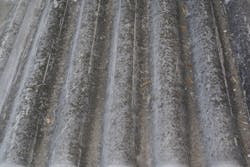What Are You Zincing About?
Zinc can be a particularly problematic compound on industrial sites because the source of zinc in storm water discharges is often hard to determine. Industrial storm water often contains a mix of metals, sediment, oil and grease, and other potential pollutants with many potential sources from your industrial site or your neighbor’s (or nearby non-industrial operations). Industrial or Multi-Sector General Permits that require monitoring for zinc typically use total zinc concentration, which will include both the dissolved zinc and particulate zinc fractions in the analysis. This means that the zinc concentration you are reading on your facility’s laboratory report is potentially caused by more than one source. The best management practices (BMPs) a facility employs to reduce its zinc concentrations will need to correspond to their site-specific zinc source(s) and the fraction, particulate and/or dissolved, contributing to most to the exceedances of benchmarks. In addition, like most industrial storm water situations, a site’s BMPs will consist of both structural (e.g. filter socks) and non-structural BMPs (e.g. site sweeping) to reduce zinc concentrations.
Zinc Background
The U.S. Environmental Protection Agency (EPA) administers the Multi-Sector General Permit (MSGP) for four states: New Mexico, Idaho, Massachusetts and New Hampshire. In the MSGP, the benchmark is hardness dependent from 0.04 to 0.26 mg/L. The harder the water, the less bioavailable zinc is to aquatic organisms, and therefore the higher the zinc concentration that is allowed in storm water discharges. The benchmarks or Numeric Action Levels (NALs), which is used in California, range from 0.117 mg/L (Washington) to 0.12 mg/L (Oregon) to 0.26 mg/L (California). According to an Oregon Department of Environmental Quality (DEQ) report, zinc concentrations of 0.09 mg/L in the water body can be toxic to marine organisms and at 0.0056 mg/l can be toxic to freshwater organisms. Note that Industrial General Permit (IGP) or MSGP have benchmarks for the discharge point (end of pipe) and the toxicity measured by the Oregon DEQ was in the receiving water body, where some mixing of the receiving water body and industrial discharge will occur. However, the potential toxicity of zinc, which can alter aquatic organisms’ behavior, impair reproduction, and reduce their growth is the driving factor for the regulatory agencies focus on zinc concentrations in industrial storm water discharges. For industrial facilities above the benchmarks or NALs, the challenge is determining the source(s) of zinc in order to most effectively deploy BMPs.
Zinc Sources
While zinc can come from a facility’s own processes (e.g. plating), many times the source is not clear. From nails to chain-link fences to sheet metal roofs, galvanized metal products are everywhere on industrial facilities. Galvanization is used to protect the underlying metal (e.g. steel) from corrosion and is typically done via a hot dipping process. As rain hits galvanized products, the zinc will corrode, instead of the steel, and wash off into storm water discharges as dissolved zinc. A major source of zinc (61%) in industrial storm water was found by a University of Wisconsin study to be from roofs, likely due to galvanized sheet metal materials.
A distant second, parking lots (29%) were the other major contributor. Zinc from parking lots could come from nearby exposed soil that can be naturally occurring in sediment, that washes onto a facility’s parking lot. Likewise, aerial deposition from building material processing or even track out from neighbors (and then track on to your site via trucks or employee vehicles) could be the source of a facility’s zinc troubles. More likely parking lot zinc sources are from vehicles. Forklift tires, which contain zinc added during the rubber vulcanization process, turn and pivot a lot on active sites. The grinding of tire rubber on paved surfaces creates small zinc containing particulates that site on the ground surface until the next storm event. Brake pad dust also contributes to the zinc particulates found on paved surfaces. As if those were not enough potential sources, motor, lube, and hydraulic oil can contain approximately 0.1% zinc by weight (1,000 mg/L), which will show up as dissolved zinc. Paints, wood preservatives, brass products and moss killers round out the list of potential zinc sources for industrial facilities to consider prior to picking BMPs.
BMPs for Zinc Reduction
For galvanized metal surfaces, painting can reduce the surface contact with storm water. Likewise, looking at storm water piping and sample points to ensure there are not galvanized parts right before sampling might help. Aerially deposited dust with zinc compounds can be washed off of the roof by conducting regular roof cleanings. Why? Zinc issues often go hand in hand with sediment issues. Remove the sediment and you remove (most of) the zinc. In addition, zinc filters, which often contain zeolites as a filtration media, can be installed on roof downspouts to remove dissolved and particulate zinc prior to discharge on the ground surface, via adsorption and physical filtration respectively. A planter with a nice looking tree or shrub can go a long way towards removing roof sediment from runoff and the zinc that might be in it.
The best BMP around, housekeeping, can do a lot towards keeping sediment and zinc particulates out of the storm water system. Regular site sweeping and not just a quick whisk, but a deep sweep weekly or monthly, does wonders. Just make sure to get into the corners, crannies, and along the curb to grab every last bit of sediment that lurks. For industrial sites with sediment built up in catch basins and storm water pipes, a fresh start is likely necessary. Using pressurized water, jetting, and a vacuum truck can give a storm water system new life and remove historical sediments, which may have been deposited during the previous tenants’ reign. Lastly, it may be worthwhile to re-route employee traffic or designate no drive zones in industrial areas if track-on from city streets or neighboring properties is an issue.
For zinc containing oils, which usually shows up as dissolved zinc in storm water samples, the best BMP is preventative maintenance. If your equipment and vehicles are still dripping and leaking, truck diapers and drip pans will help as a source control BMP to limit the amount of dissolved zinc exposed to storm water sheet flow during the next storm event. An intensive preventative maintenance program, aggressive clean up methods, and a robust training program (e.g. pre-trip truck inspections and immediate repair of drips) all help reduce the zinc sources that contribute a significant amount of dissolved zinc to a facility’s storm water discharges.
Stumped as to the Source?
Look to your neighbor next. Is run-on coming from their site, which may or may not have a permit and probably does not take storm water as seriously as your industrial facility? Did your industrial facility do a deep clean of their storm water system to remove historical sediments? Are there any cross-connections or undiscovered floor drains that lead into the storm water system?
From galvanized fences (dissolved zinc) to forklift tire dust (particulate zinc) to motor oil (dissolved zinc), industrial facilities have their work cut out for them finding the source(s) of zinc benchmark exceedances. However, with some great non-structural BMPs, such as site sweeping, preventative maintenance, and good housekeeping, a facility might limit the structural BMPs, such as zeolite roof filters and truck diapers needed. However, at the end of the day the source of zinc may not be due to a facility’s industrial activities, such as naturally occurring soils. If the zinc exceedances are linked to industrial activities and the initial non-structural and structural BMPs are not sufficient, an industrial facility will need to look to structural treatment BMPs, such as bio-retention cells or biochar filtration media cartridges or electrocoagulation systems to meet their permit requirements.


